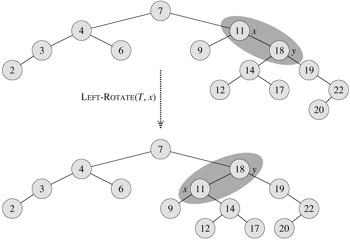| < Day Day Up > |
The search-tree operations TREE-INSERT and TREE-DELETE, when run on a red-black tree with n keys, take O(lg n) time. Because they modify the tree, the result may violate the red-black properties enumerated in Section 13.1. To restore these properties, we must change the colors of some of the nodes in the tree and also change the pointer structure.
We change the pointer structure through rotation, which is a local operation in a search tree that preserves the binary-search-tree property. Figure 13.2 shows the two kinds of rotations: left rotations and right rotations. When we do a left rotation on a node x, we assume that its right child y is not nil[T]; x may be any node in the tree whose right child is not nil[T]. The left rotation "pivots" around the link from x to y. It makes y the new root of the subtree, with x as y's left child and y's left child as x's right child.

The pseudocode for LEFT-ROTATE assumes that right[x] ≠ nil[T] and that the root's parent is nil[T].
LEFT-ROTATE(T, x) 1 y ← right[x] ▹ Set y. 2 right[x] ← left[y] ▹ Turn y's left subtree into x's right subtree. 3 p[left[y]] ← x 4 p[y] ← p[x] ▹ Link x's parent to y. 5 if p[x] = nil[T] 6 then root[T] ← y 7 else if x = left[p[x]] 8 then left[p[x]] ← y 9 else right[p[x]] ← y 10 left[y] ← x ▹ Put x on y's left. 11 p[x] ← y
Figure 13.3 shows how LEFT-ROTATE operates. The code for RIGHT-ROTATE is symmetric. Both LEFT-ROTATE and RIGHT-ROTATE run in O(1) time. Only pointers are changed by a rotation; all other fields in a node remain the same.

Argue that in every n-node binary search tree, there are exactly n - 1 possible rotations.
Let a, b, and c be arbitrary nodes in subtrees α, β, and γ, respectively, in the left tree of Figure 13.2. How do the depths of a, b, and c change when a left rotation is performed on node x in the figure?
Show that any arbitrary n-node binary search tree can be transformed into any other arbitrary n-node binary search tree using O(n) rotations. (Hint: First show that at most n - 1 right rotations suffice to transform the tree into a right-going chain.)
We say that a binary search tree T1 can be right-converted to binary search tree T2 if it is possible to obtain T2 from T1 via a series of calls to RIGHT-ROTATE. Give an example of two trees T1 and T2 such that T1 cannot be right-converted to T2. Then show that if a tree T1 can be right-converted to T2, it can be right-converted using O(n2) calls to RIGHT-ROTATE.
| < Day Day Up > |